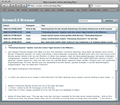Screen2.0
news, feature // 2010.11.09 08:09:08 [hh]
Runde Sache: "World Wide Web" wird 20
Am 13. November 1990 wurde die erste Web-Site "info.cern.ch" von dem britischen Physiker Tim Berners-Lee am Europäischen Kernforschungszentrum CERN bei Genf (Schweiz) veröffentlicht. Seitdem ist viel passiert. Heute gibt es 13,8 Millionen Homepages allein in Deutschland. Dazu kommen rund 90 Millionen com-Domains. Screen2.0 erzählt die Hintergründe einer beispiellosen Erfolgsgeschichte.
Die Idee zur Website entstand ursprünglich als Teil des World Wide Web-Projekts am CERN. Es sollte die Informationsflut in komplexen wissenschaftlichen Projekten besser beherrschbar machen. Auf der ersten CERN-Webseite wurde unter anderem erklärt, was das "World Wide Web" ist, welche Personen daran beteiligt sind und wie man einen Browser benutzt. Und so sah sie aus: www.w3.org/ History/ 19921103- hypertext/ hypertext/ WWW/ TheProject.html.
In Deutschland ist die Zahl der Webseiten seit Beginn des Internet-Booms im Jahr 1999 stetig und weitgehend gleichmäßig angestiegen. Deutsche Webseiten-Inhaber – Unternehmen oder Privatleute – nutzen vor allem Adressen der so genannten Top Level Domain „.de“. 13,8 Millionen Home-pages (Domains) mit der deutschen Endung .de sind zurzeit bei der Registrierungsstelle Denic angemeldet. Weltweit führend mit etwa 90 Millionen sind Webadressen mit der Endung „.com“. Die seit rund vier Jahren existierende Endung „.eu“ kommt immerhin schon auf 3,2 Millionen Webseiten.
Berner-Lees Erfindung ist nicht mehr wegzudenken aus dem Privat- und vor allem dem Geschäftsleben. Allerdings gibt es noch immer Nachholbedarf. Jedes fünfte deutsche Unternehmen hat auch heute immer noch keinen eigenen Internetauftritt. Dabei handelt es sich im Wesentlichen um kleine Firmen. "Gerade Handwerksbetriebe, kleinere Büros, Selbständige oder auch Einzelhändler können von einem Internetauftritt massiv profitieren. Diese Chancen einer Internetpräsenz sollten auch von kleinen Firmen noch stärker in den Blick genommen werden."
"... and the rest is Web history"
Die Web-Site info.sern.ch heute: "1990 was a momentous year in world events. In February, Nelson Mandela was freed after 27 years in prison. In April, the space shuttle Discovery carried the Hubble Space Telescope into orbit. And in October, Germany was reunified.
Then at the end of 1990, a revolution took place that changed the way we live today.
CERN, the European Organization for Nuclear Research, is where it all began in March 1989. A physicist, Tim Berners-Lee, wrote a proposal for information management showing how information could be transferred easily over the Internet by using hypertext, the now familiar point-and-click system of navigating through information. The following year, Robert Cailliau, a systems engineer, joined in and soon became its number one advocate.
The idea was to connect hypertext with the Internet and personal computers, thereby having a single information network to help CERN physicists share all the computer-stored information at the laboratory. Hypertext would enable users to browse easily between texts on web pages using links. The first examples were developed on NeXT computers.
Berners-Lee created a browser-editor with the goal of developing a tool to make the Web a creative space to share and edit information and build a common hypertext. What should they call this new browser: The Mine of Information? The Information Mesh? When they settled on a name in May 1990, it was the WorldWideWeb.
Info.cern.ch was the address of the world's first-ever web site and web server, running on a NeXT computer at CERN. The first web page address was http://info.cern.ch/hypertext/WWW/TheProject.html, which centred on information regarding the WWW project. Visitors could learn more about hypertext, technical details for creating their own webpage, and even an explanation on how to search the Web for information. There are no screenshots of this original page and, in any case, changes were made daily to the information available on the page as the WWW project developed. You may find a later copy (1992) on the World Wide Web Consortium website.
However, a website is like a telephone; if there's just one it's not much use. Berners-Lee's team needed to send out server and browser software. The NeXT systems however were far advanced over the computers people generally had at their disposal: a far less sophisticated piece of software was needed for distribution.
By spring of 1991, testing was underway on a universal line mode browser, which would be able to run on any computer or terminal. It was designed to work simply by typing commands. There was no mouse, no graphics, just plain text, but it allowed anyone with an Internet connection access to the information on the Web.
During 1991 servers appeared in other institutions in Europe and in December 1991, the first server outside the continent was installed in the US at SLAC (Stanford Linear Accelerator Center). By November 1992, there were 26 servers in the world, and by October 1993 the figure had increased to over 200 known web servers. In February 1993, the National Center for Supercomputing Applications (NCSA) at the University of Illinois at Urbana-Champaign released the first version of Mosaic, which was to make the Web available to people using PCs and Apple Macintoshes.
... and the rest is Web history.
Although the Web's conception began as a tool to aid physicists answer tough questions about the Universe, today its usage applies to various aspects of the global community and affects our daily lives.
Today there are upwards of 80 million websites, with many more computers connected to the Internet, and hundreds of millions of users. If households nowadays want a computer, it is not to compute, but to go on the Web."
(Quelle: info.cern.ch)
Werbung












